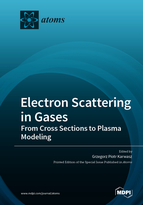Electron Scattering in Gases –from Cross Sections to Plasma Modeling
A special issue of Atoms (ISSN 2218-2004).
Deadline for manuscript submissions: closed (15 November 2021) | Viewed by 40824
Special Issue Editor
Special Issue Information
Dear Colleagues,
The first experiments on electron scattering were completed before the “official” discovery of this particle by J. J. Thomson. In spite of this, our knowledge of cross sections is still far from complete.
More recent experiments had some unexpected results, like selective fragmentation of DNA constituents by low-energy electrons, or “reverse” phenomena, i.e., synthesis of simple amino acids from inorganic precursors, triggered by slow electrons. The most recent need for cross sections comes from modeling plasmas for industrial and thermonuclear applications, and atmospheres of solar and extra-solar planets.
Both fundamental research (experiments, theory, reviews) and applications of electron-scattering cross sections in various processes are welcome.
Prof. Grzegorz Piotr Karwasz
Guest Editor
Manuscript Submission Information
Manuscripts should be submitted online at www.mdpi.com by registering and logging in to this website. Once you are registered, click here to go to the submission form. Manuscripts can be submitted until the deadline. All submissions that pass pre-check are peer-reviewed. Accepted papers will be published continuously in the journal (as soon as accepted) and will be listed together on the special issue website. Research articles, review articles as well as short communications are invited. For planned papers, a title and short abstract (about 100 words) can be sent to the Editorial Office for announcement on this website.
Submitted manuscripts should not have been published previously, nor be under consideration for publication elsewhere (except conference proceedings papers). All manuscripts are thoroughly refereed through a single-blind peer-review process. A guide for authors and other relevant information for submission of manuscripts is available on the Instructions for Authors page. Atoms is an international peer-reviewed open access monthly journal published by MDPI.
Please visit the Instructions for Authors page before submitting a manuscript. The Article Processing Charge (APC) for publication in this open access journal is 1500 CHF (Swiss Francs). Submitted papers should be well formatted and use good English. Authors may use MDPI's English editing service prior to publication or during author revisions.






